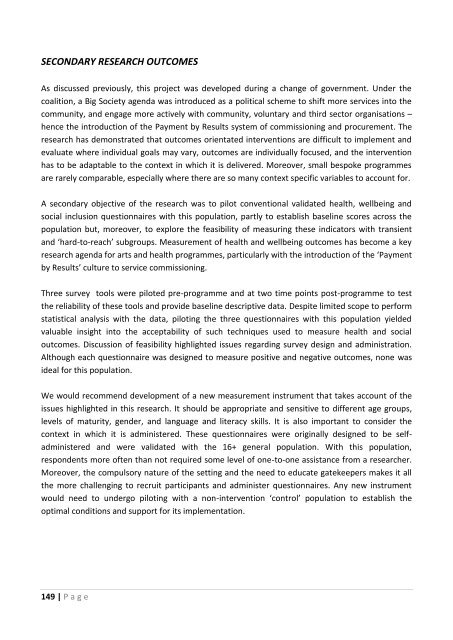De Viggiani, N., Daykin, N., Moriarty, Y. and Pilkington, P. and ...
De Viggiani, N., Daykin, N., Moriarty, Y. and Pilkington, P. and ...
De Viggiani, N., Daykin, N., Moriarty, Y. and Pilkington, P. and ...
Create successful ePaper yourself
Turn your PDF publications into a flip-book with our unique Google optimized e-Paper software.
SECONDARY RESEARCH OUTCOMES<br />
As discussed previously, this project was developed during a change of government. Under the<br />
coalition, a Big Society agenda was introduced as a political scheme to shift more services into the<br />
community, <strong>and</strong> engage more actively with community, voluntary <strong>and</strong> third sector organisations –<br />
hence the introduction of the Payment by Results system of commissioning <strong>and</strong> procurement. The<br />
research has demonstrated that outcomes orientated interventions are difficult to implement <strong>and</strong><br />
evaluate where individual goals may vary, outcomes are individually focused, <strong>and</strong> the intervention<br />
has to be adaptable to the context in which it is delivered. Moreover, small bespoke programmes<br />
are rarely comparable, especially where there are so many context specific variables to account for.<br />
A secondary objective of the research was to pilot conventional validated health, wellbeing <strong>and</strong><br />
social inclusion questionnaires with this population, partly to establish baseline scores across the<br />
population but, moreover, to explore the feasibility of measuring these indicators with transient<br />
<strong>and</strong> ‘hard-to-reach’ subgroups. Measurement of health <strong>and</strong> wellbeing outcomes has become a key<br />
research agenda for arts <strong>and</strong> health programmes, particularly with the introduction of the ‘Payment<br />
by Results’ culture to service commissioning.<br />
Three survey tools were piloted pre-programme <strong>and</strong> at two time points post-programme to test<br />
the reliability of these tools <strong>and</strong> provide baseline descriptive data. <strong>De</strong>spite limited scope to perform<br />
statistical analysis with the data, piloting the three questionnaires with this population yielded<br />
valuable insight into the acceptability of such techniques used to measure health <strong>and</strong> social<br />
outcomes. Discussion of feasibility highlighted issues regarding survey design <strong>and</strong> administration.<br />
Although each questionnaire was designed to measure positive <strong>and</strong> negative outcomes, none was<br />
ideal for this population.<br />
We would recommend development of a new measurement instrument that takes account of the<br />
issues highlighted in this research. It should be appropriate <strong>and</strong> sensitive to different age groups,<br />
levels of maturity, gender, <strong>and</strong> language <strong>and</strong> literacy skills. It is also important to consider the<br />
context in which it is administered. These questionnaires were originally designed to be selfadministered<br />
<strong>and</strong> were validated with the 16+ general population. With this population,<br />
respondents more often than not required some level of one-to-one assistance from a researcher.<br />
Moreover, the compulsory nature of the setting <strong>and</strong> the need to educate gatekeepers makes it all<br />
the more challenging to recruit participants <strong>and</strong> administer questionnaires. Any new instrument<br />
would need to undergo piloting with a non-intervention ‘control’ population to establish the<br />
optimal conditions <strong>and</strong> support for its implementation.<br />
149 | P a g e
















